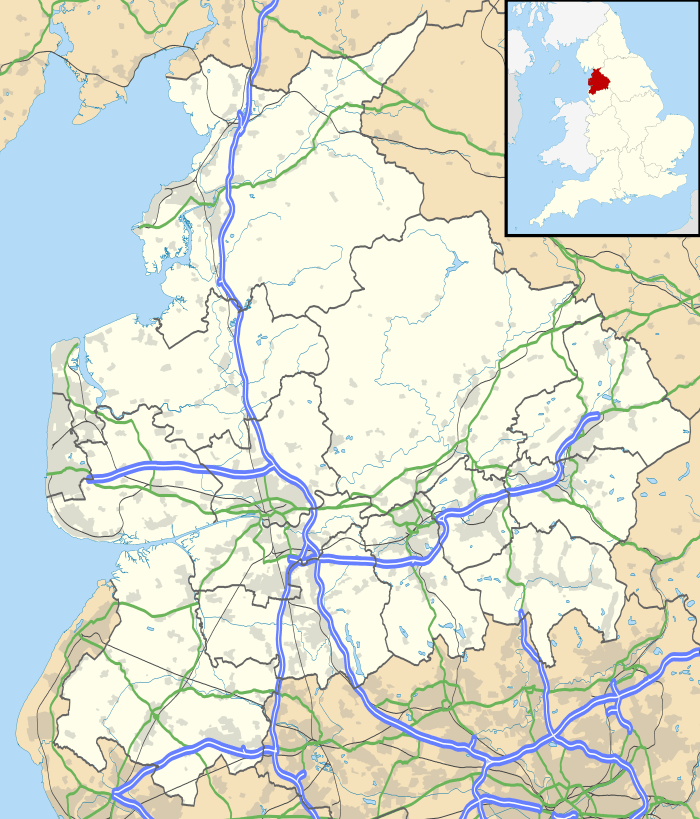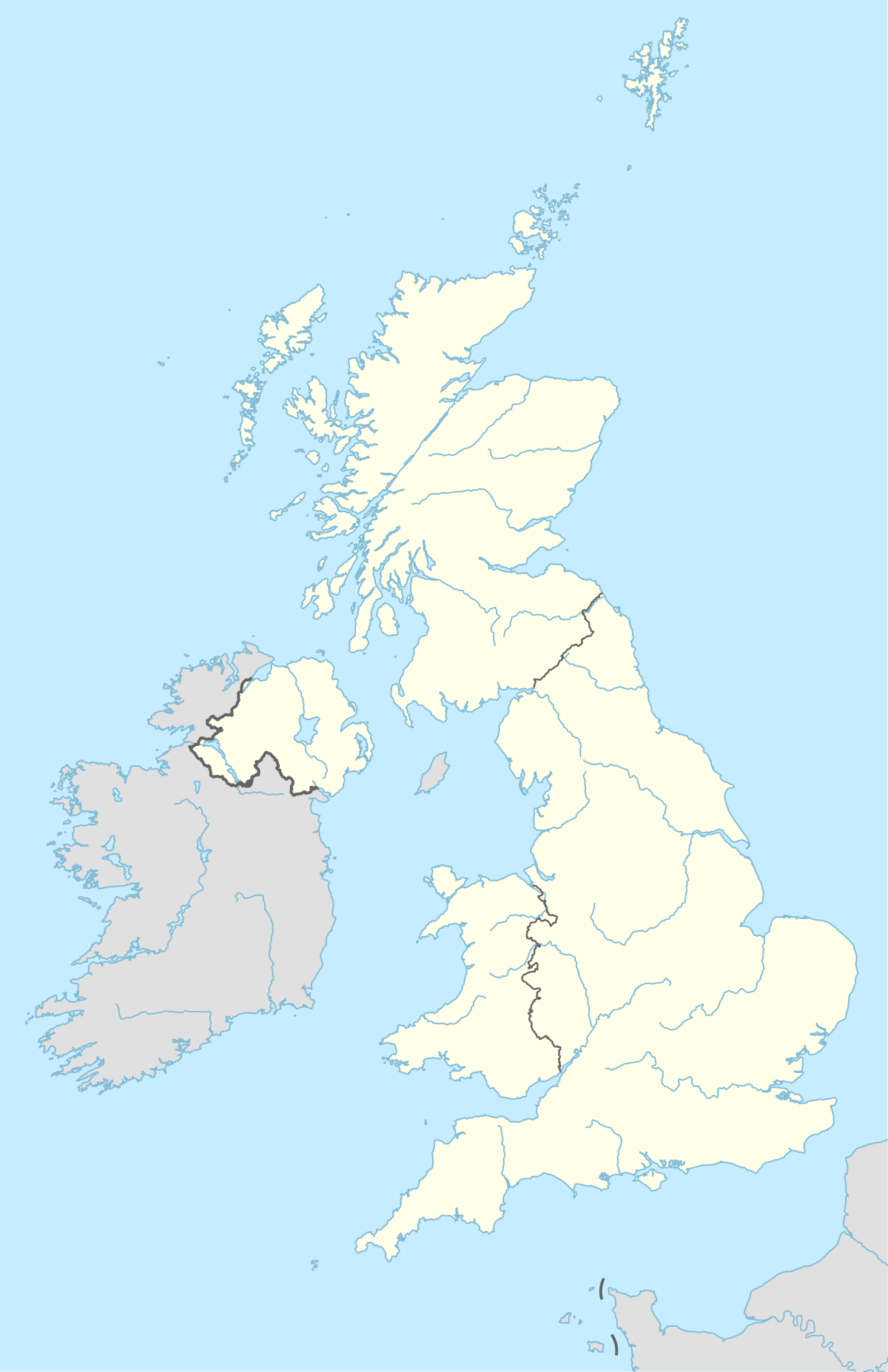Battle of Bamber Bridge
| Battle of Bamber Bridge | |||
|---|---|---|---|
.jpg) Ye Old Hob Inn, where the violence started | |||
| Date | 24–25 June 1943 | ||
| Location |
Bamber Bridge, Lancashire, United Kingdom 53°43′18″N 2°39′44″W / 53.7217°N 2.6621°WCoordinates: 53°43′18″N 2°39′44″W / 53.7217°N 2.6621°W | ||
| Caused by | Racial tensions | ||
| Methods | Mutiny | ||
| Parties to the civil conflict | |||
| |||
| Casualties | |||
| Death(s) | 1 | ||
| Injuries | 7 | ||
| Charged | 32 | ||
 Location of Bamber Bridge  Battle of Bamber Bridge (the United Kingdom) | |||
The Battle of Bamber Bridge was an outbreak of racial violence and mutiny that began in the evening of 24 June 1943 among American servicemen stationed in the British village of Bamber Bridge, Lancashire. Coming just days after the 1943 Detroit race riot, the incident was provoked by the attempted arrest by white Military Police (MPs) of several black soldiers from the racially segregated 1511th Quartermaster Truck Regiment in Ye Old Hob Inn public house. The incident was made worse by the arrival of more military police armed with machine guns and the response of black soldiers who raided their base's armoury and armed themselves with rifles. Exchanges of fire took place until the early hours of 25 June. One soldier was killed and several MPs and soldiers injured. A court martial convicted 32 soldiers of mutiny and related crimes but blamed poor leadership and racist attitudes among the MPs.[1]
Background
During the Second World War, Bamber Bridge hosted American servicemen from the 1511th Quartermaster Truck regiment, part of the Eighth Air Force. Their base, Air Force Station 569 (nicknamed "Adam Hall"), was situated on Mounsey Road, part of which still exists now as home to 2376 (Bamber Bridge) Squadron of the Air Training Corps (or Air Cadets). The 1511th Quartermaster Truck was a logistics unit, and its duty was to deliver materiel to other Eighth Air Forces bases in Lancashire.[2] The 234th US Military Police Company were also located in the town, on its north side.[1]
US Armed Forces were still racially segregated, and the soldiers of 1511 Quartermaster Truck were almost entirely black, while all but one of the officers were white, as were the MPs. Military commanders tended to treat these service units as "dumping grounds" for less competent officers, and leadership in the unit was poor.[3] Racial tensions were exacerbated by the riots in Detroit earlier that week which had led to 34 deaths, including 25 black casualties.[4] The people of Bamber Bridge supported the black troops, and when American commanders demanded a colour bar in the town, all three pubs in the town reportedly posted "Black Troops Only" signs.[5]
Cause
On the night of 24 June, some soldiers were drinking with Bamber Bridge townspeople in Ye Old Hob Inn. After last orders were called at 10:00 p.m., several soldiers attempted to buy more beer and were refused. Two passing MPs, Corporal Roy A. Windsor and Private First Class Ralph F. Ridgeway, were alerted by the officers and when they arrived, Ridgeway attempted to arrest one soldier (Private Eugene Nunn) who was improperly dressed (in a field jacket rather than class A uniform) and did not have a pass. An argument ensued between the black soldier and the white MPs, with local people and British servicewomen of the Auxiliary Territorial Service siding with Nunn and the small group of comrades he was with.[1]
One soldier, Private Lynn M. Adams, advanced on the MPs with a bottle, and Windsor drew his gun in response. Black Staff Sergeant William Byrd was able to defuse the situation, but as the MPs left Adams threw his beer at their jeep. After driving away, the MPs picked up two reinforcements, Private First Class Carson W. Bozman and Private Spurlock Mullins, and then caught up with the unit's officers, Captain Julius F. Hirst and Lieutenant Gerald C. Windsor. The officers were unable to help, and told Windsor to do his duty and arrest the soldiers. The MPs intercepted the soldiers on Station Road, the only route back to the base. What happened next is disputed: two black soldiers who were not involved in the violence claimed that the MPs threatened the soldiers, shouting "By God men, come on!", while a British Special Constable who was nearby said the MPs were initially peaceful and stopped to talk to Adams who was drinking in the road.[1]
As they approached, Private Nunn threw a punch at Ridgeway, and a melee broke out. Bozman drew his gun and fired, hitting Adams in the neck. The crowd scattered, and jeeps arrived to rescue the wounded. Four black soldiers reported that the officers refused to take them to hospital. As the injured soldiers returned to the base, rumours began to spread that the MPs were out to shoot black soldiers, and panic spread around the base. A few soldiers slipped out, perhaps hoping to find the MPs and get revenge, but the majority stayed on base. The colonel was absent, and so it fell to Major George C. Heris to calm the situation. Lieutenant Edwin D. Jones, the only black officer in the ranks, was able to persuade the soldiers that Heris would be able to round up the MPs and see that justice was done.[1][3]
Spread
At midnight, several jeeps full of MPs arrived at the camp, including one improvised armoured car armed with a large machine gun. A general panic broke out, resulting in black soldiers arming themselves from the camp gun room. Around two-thirds of the rifles were taken, and a large group of men left the base in pursuit of the MPs.[1]
The soldiers warned the townspeople to stay inside, and began shooting at the MPs, who returned fire. The darkness meant that both sides were confused and few shots were fired. However, one black soldier, Private William Crossland, was killed, and four people were wounded (two soldiers and two MPs). Shooting continued until around 4 a.m. the next morning. Eventually, the soldiers returned to the base, and by the afternoon all but four rifles had been recovered.[1][3]
Aftermath
The violence left one man dead and seven people (five soldiers and two MPs) injured.[3] At court martial, 32 were found guilty of various crimes including mutiny, seizing arms, rioting, and firing upon officers and MPs. The sentences were all reduced on appeal, with the poor leadership and use of racial slurs by MPs considered mitigating factors. General Ira C. Eaker, commander of the Eighth Air Force, placed the majority of the blame on the white officers and MPs and to prevent such an incident happening again, he combined the black trucking units into a single special command. The ranks of this command were purged of inexperienced and racist officers, and the MP patrols were racially integrated. Morale among black troops stationed in England improved, and the rates of courts-martial and venereal disease both fell, although there were several more minor conflicts between black and white American troops in Britain during the war.[2][5]
The incident is briefly mentioned in Anthony Burgess's autobiography, Little Wilson and Big God, Being the First Part of the Confessions of Anthony Burgess.[5]
In June 2013, to commemorate the 70th anniversary of the incident, the University of Central Lancashire held a symposium.[6] It included a screening of the 2009 documentary Choc’late Soldiers from the USA[upper-alpha 1] which was produced by Gregory Cooke, and a performance of Lie Back and Think of America, a play written by Natalie Penn of Front Room that had played at the Edinburgh Fringe Festival.[6]
References
Notes
- ↑ "A landmark documentary explores how African American soldiers and British civilians formed an unexpected bond during World War II" which had its world premier at the Smithsonian Institution National Museum of African American History and Culture on 10 November 2009. American History and Culture[7]
Citations
- 1 2 3 4 5 6 7 Werrell, Ken (1978). Ramsey, Winston G., ed. "The Mutiny at Bamber Bridge". After the Battle. No. 22. pp. 1–11.
- 1 2 Miller, Donald L. (2007). Masters of the Air: America's Bomber Boys Who Fought the Air War Against Nazi Germany. New York, NY: Simon and Schuster. pp. 227–229. ISBN 9780743235457.
- 1 2 3 4 Nalty, Bernard C. (1 January 1986). Strength for the Fight: A History of Black Americans in the Military. Simon and Schuster, Free Press. pp. 154–157, 228. ISBN 9780029224113.
- ↑ "When the American military said sorry to Bamber Bridge". Lancashire Evening Post. 12 April 2012. Retrieved 2 June 2017.
- 1 2 3 Pollins, Harold. "WW2 People's War – The Battle of Bamber Bridge". BBC. Retrieved 4 April 2017.
- 1 2 "Sollis Marks 70th Anniversary of Battle of Bamber Bridge". Lancashire, U.K.: University of Central Lancashire. Retrieved 2 June 2017.
- ↑ "Choc'late Soldiers from the USA: Love, War and Change" (PDF). Journal of African American History. Retrieved 2 June 2017.